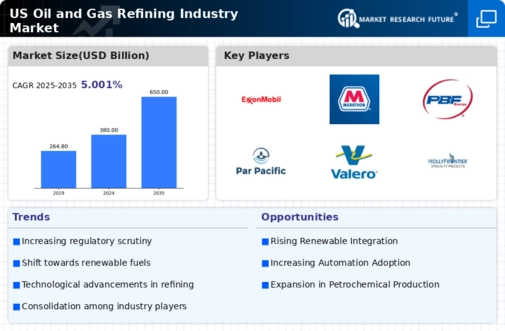Fluctuating Crude Oil Prices
The oil gas-refining-industry market is heavily impacted by the volatility of crude oil prices, which can fluctuate due to geopolitical tensions, supply chain disruptions, and changes in production levels by OPEC+. As of November 2025, crude oil prices are projected to hover around $80 per barrel, which presents both challenges and opportunities for refiners. High crude prices can squeeze refining margins, compelling operators to enhance efficiency and reduce costs. Conversely, lower prices may stimulate demand for refined products, potentially increasing throughput. Thus, refiners must remain agile and responsive to these price fluctuations to maintain profitability in the oil gas-refining-industry market.
Shifts in Consumer Demand for Fuels
The oil gas-refining-industry market is currently navigating shifts in consumer demand for fuels, particularly with the increasing popularity of electric vehicles (EVs) and alternative fuels. As of November 2025, it is estimated that EVs could account for approximately 25% of new vehicle sales in the US, prompting refiners to adapt their product offerings. This transition may lead to a decline in gasoline demand, which has historically been a primary product of the refining process. Consequently, refiners are exploring diversification strategies, including the production of biofuels and renewable diesel, to meet evolving consumer preferences. This shift could reshape the competitive landscape of the oil gas-refining-industry market.
Technological Advancements in Refining Processes
The oil gas-refining-industry market is experiencing a notable shift due to technological advancements that enhance refining efficiency. Innovations such as hydrocracking and catalytic reforming are becoming increasingly prevalent, allowing refineries to process heavier crude oils into higher-value products. These technologies not only improve yield but also reduce operational costs, which is crucial in a competitive market. In 2025, the average refining margin in the US is projected to be around $15 per barrel, indicating a robust economic environment for refiners adopting these technologies. Furthermore, the integration of automation and AI in refining operations is expected to optimize production schedules and minimize downtime, thereby driving profitability in the oil gas-refining-industry market.
Regulatory Compliance and Environmental Standards
The oil gas-refining-industry market is significantly influenced by stringent regulatory compliance and environmental standards imposed by federal and state agencies. The US government has implemented various regulations aimed at reducing emissions and promoting cleaner refining practices. For instance, the implementation of the Clean Air Act has led to the adoption of advanced emission control technologies in refineries. As of 2025, it is estimated that compliance costs could account for up to 10% of total operational expenses for refineries. This regulatory landscape compels refiners to invest in cleaner technologies, which, while initially costly, may lead to long-term savings and improved market positioning within the oil gas-refining-industry market.
Investment in Infrastructure and Capacity Expansion
The oil gas-refining-industry market is witnessing a trend towards investment in infrastructure and capacity expansion as refiners seek to enhance their competitive edge. In 2025, it is anticipated that capital expenditures in the refining sector will reach approximately $10 billion, driven by the need to upgrade aging facilities and expand processing capabilities. This investment is crucial for meeting the growing demand for refined products, particularly in regions experiencing economic growth. Additionally, refiners are focusing on building more resilient supply chains to mitigate risks associated with disruptions. Such strategic investments are likely to bolster the operational capacity and market presence of players in the oil gas-refining-industry market.





















Leave a Comment